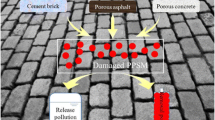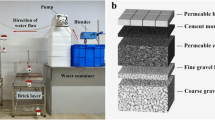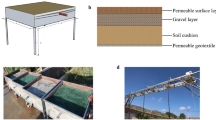Abstract
To investigate the effect of different permeable pavement surface materials on the removal of pollutants from urban storm-runoff, six commonly surface materials (porous asphalt, porous concrete, cement brick, ceramic brick, sand base brick, and shale brick) were selected in this study and the research was carried out by column experiments. Except the concentrations of total suspended solids (TSS), chemical oxygen demand (COD), ammonia nitrogen (NH4-N), nitrate nitrogen (NO3-N), total nitrogen (TN), and total phosphorus (TP) in the influent and effluent that were measured, the removal mechanism of pollutants was discussed further. The results indicate that the surface materials influence the removal efficiency of pollutants greatly and have different effects on certain pollutant. Furthermore, the physical interception and adsorption would be the main mechanism for the removal of pollutants from runoff. For example, for all surface materials, the average removal efficiency of TSS is nearly about 90.0% because of physical interception. Due to the amount of iron oxide, the removal efficiency of COD, NO3-N, and TN of shale brick was 88.2, 35.1, and 17.5%, respectively. NH4-N and TN can be easily removed by porous asphalt due to the high content of organic matter. By lacking of useful adsorption sites, all the surface materials had little effect on the removal of TP from runoff. This research could offer useful guidelines for the better design of permeable pavement system and promote the insight into the removal mechanism of pollutants in permeable pavement system.

Different types of materials for the different types of pollutants in the runoff purification capacity were significantly different, overall, shale brick and porous asphalt Shale bricks and porous asphalt have a better purification effect according to the six kinds of materials








Similar content being viewed by others
References
Antunes L, Thives L, Ghisi E (2016) Potential for potable water savings in buildings by using stormwater harvested from porous pavements. Water 8:110–128
Barrett ME (2008) Effects of a permeable friction course on highway runoff. J Irrig Drain Eng 134:646–651
Bean EZ, Hunt WF, Bidelspach DA (2007) Evaluation of four permeable pavement sites in eastern North Carolina for runoff reduction and water quality impacts. J Irrig Drain Eng-ASCE 133:583–592
Brattebo BO, Booth DB (2003) Long-term stormwater quantity and quality performance of permeable pavement systems. Water Res 37:4369–4376
Brezonik PL, Stadelmann TH (2002) Analysis and predictive models of stormwater runoff volumes, loads, and pollutant concentrations from watersheds in the Twin Cities metropolitan area, Minnesota, USA. Water Res 36:1743–1757
Brown RA, Borst M (2015) Nutrient infiltrate concentrations from three permeable pavement types. J Environ Manag 164:74–85
Brown C, Chu A, Duin BV, Valeo C, Marsalek J, Schreier H (2009) Characteristics of sediment removal in two types of permeable pavement. Water Qual Res J Can 44:59–70
China (2002) Environmental quality standards for surface water. Chinese Environmental Protection Industry, pp 1–9
Collins KA, Hunt WF, Hathaway JM (2008) Hydrologic comparison of four types of permeable pavement and standard asphalt in Eastern North Carolina. J Hydrol Eng 13:1146–1157
Collins KA, Hunt WF, Hathaway JM (2010) Side-by-side comparison of nitrogen species removal for four types of permeable pavement and standard asphalt in Eastern North Carolina. J Hydrol Eng 15:512–521
Dietz ME (2007) Low impact development practices: a review of current research and recommendations for future directions. Water Air Soil Pollut 22:351–363
Drake J, Bradford A, van Seters T (2014a) Stormwater quality of spring-summer-fall effluent from three partial-infiltration permeable pavement systems and conventional asphalt pavement. J Environ Manag 139:69–79
Drake J, Bradford A, Van Seters T (2014b) Winter effluent quality from partial-infiltration permeable pavement systems. J Environ Eng 140
Eck BJ, Winston RJ, Hunt WF, Barrett ME (2012) Water quality of drainage from permeable friction course. J Environ Eng 138:174–181
Fassman EA, Blackbourn SD (2011) Road runoff water-quality mitigation by permeable modular concrete pavers. J Irrig Drain Eng 137:720–729
Gnecco I, Berretta C, Lanza LG, Barbera PL (2005) Storm water pollution in the urban environment of Genoa, Italy. Atmos Res 77:60–73
Hou PQ, Ren YF, Wang XK, Ouyang ZY, Zhou XP (2012) Research on evaluation of water quality of Beijing urban stormwater runoff. Environ Sci (in Chinese) 33:71
Jiang W, Sha A, Xiao J, Li Y, Huang Y (2015) Experimental study on filtration effect and mechanism of pavement runoff in permeable asphalt pavement. Constr Build Mater 100:102–110
Koupai JA, Nejad SS, Mostafazadeh-Fard S, Behfarnia K (2016) Reduction of urban storm-runoff pollution using porous concrete containing iron slag adsorbent. J Environ Eng 142(04015072):1–7
Legret M, Colandini V (1999) Effects of a porous pavement with reservoir structure on runoff water: water quality and fate of heavy metals. Water Sci Technol 39:111–117
Liu W, Chen W, Feng Q, Peng C, Kang P (2016) Cost-benefit analysis of green infrastructures on community stormwater reduction and utilization: a case of Beijing, China. Environ Manag 58:1–12
Niu ZG, Lv ZW, Zhang Y, Cui ZZ (2016) Stormwater infiltration and surface runoff pollution reduction performance of permeable pavement layers. Environ Sci Pollut Res Int 23:2576–2587
Pagotto C, Legret M, Cloirec PL (2000) Comparison of the hydraulic behaviour and the quality of highway runoff water according to the type of pavement. Water Res 34:4446–4454
Roseen RM, Ballestero TP, Houle JJ, Avellaneda P, Briggs J, Fowler G, Wildey R (2009) Seasonal performance variations for storm-water management systems in cold climate conditions. J Environ Eng 135:128–137
Rushton BT (2001) Low-impact parking lot design reduces runoff and pollutant loads. J Water Resour Plan Manag 127:1–7
Sansalone J, Kuang X, Ranieri V (2008) Permeable pavement as a hydraulic and filtration interface for urban drainage. J Irrig Drain Eng 134:666–674
Soetardji JP, Claudia JC, Ju YH, Hriljac JA, Chen TY, Soetaredjo FE, Santoso SP, Kurniawan A, Ismadji S (2015) Ammonia removal from water using sodium hydroxide modified zeolite mordenite. RSC Adv 5:83689–83699
Wang M, Zhang D, Adhityan A, Ng WJ, Dong J, Tan SK (2016) Assessing cost-effectiveness of bioretention on stormwater in response to climate change and urbanization for future scenarios. J Hydrol:1–30
Wootton-Beard P, Xing Y, Prabhakaran RD, Robson P, Bosch M, Thornton J, Ormondroyd G, Jones P, Donnison I (2016) Review: improving the impact of plant science on urban planning and design. Buildings 6:48
Zhang J, Hao Z, Zhang Z, Yang Y, Xu X (2010) Kinetics of nitrate reductive denitrification by nanoscale zero-valent iron. Process Saf Environ Prot 88:439–445
Acknowledgements
This work was supported by Beijing outstanding talent project for excellent youth team (2015000026833T0000), Beijing Advanced Innovation Center of Urban Design for Future Cities: Sponge City Development and Water Quantity & Quality Risk Control (UDC2016040100), and Natural Science Foundation of China (No. 51678025).
Author information
Authors and Affiliations
Corresponding author
Additional information
Responsible editor: Philippe Garrigues
Rights and permissions
About this article
Cite this article
Li, H., Li, Z., Zhang, X. et al. The effect of different surface materials on runoff quality in permeable pavement systems. Environ Sci Pollut Res 24, 21103–21110 (2017). https://doi.org/10.1007/s11356-017-9750-6
Received:
Accepted:
Published:
Issue Date:
DOI: https://doi.org/10.1007/s11356-017-9750-6




